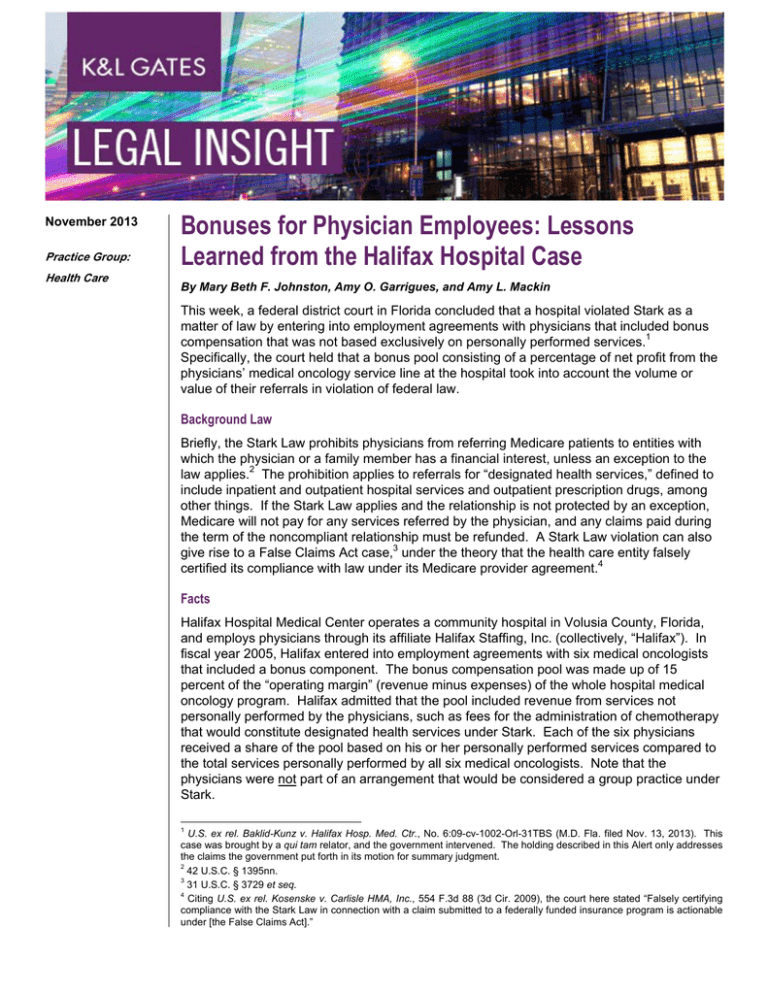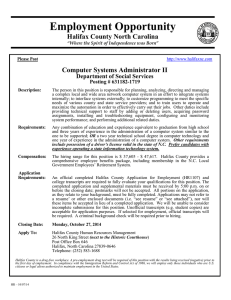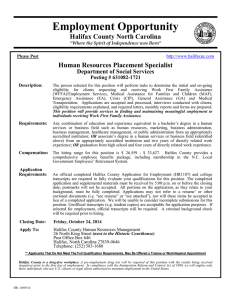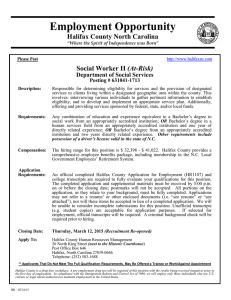
November 2013
Practice Group:
Health Care
Bonuses for Physician Employees: Lessons
Learned from the Halifax Hospital Case
By Mary Beth F. Johnston, Amy O. Garrigues, and Amy L. Mackin
This week, a federal district court in Florida concluded that a hospital violated Stark as a
matter of law by entering into employment agreements with physicians that included bonus
compensation that was not based exclusively on personally performed services.1
Specifically, the court held that a bonus pool consisting of a percentage of net profit from the
physicians’ medical oncology service line at the hospital took into account the volume or
value of their referrals in violation of federal law.
Background Law
Briefly, the Stark Law prohibits physicians from referring Medicare patients to entities with
which the physician or a family member has a financial interest, unless an exception to the
law applies.2 The prohibition applies to referrals for “designated health services,” defined to
include inpatient and outpatient hospital services and outpatient prescription drugs, among
other things. If the Stark Law applies and the relationship is not protected by an exception,
Medicare will not pay for any services referred by the physician, and any claims paid during
the term of the noncompliant relationship must be refunded. A Stark Law violation can also
give rise to a False Claims Act case,3 under the theory that the health care entity falsely
certified its compliance with law under its Medicare provider agreement.4
Facts
Halifax Hospital Medical Center operates a community hospital in Volusia County, Florida,
and employs physicians through its affiliate Halifax Staffing, Inc. (collectively, “Halifax”). In
fiscal year 2005, Halifax entered into employment agreements with six medical oncologists
that included a bonus component. The bonus compensation pool was made up of 15
percent of the “operating margin” (revenue minus expenses) of the whole hospital medical
oncology program. Halifax admitted that the pool included revenue from services not
personally performed by the physicians, such as fees for the administration of chemotherapy
that would constitute designated health services under Stark. Each of the six physicians
received a share of the pool based on his or her personally performed services compared to
the total services personally performed by all six medical oncologists. Note that the
physicians were not part of an arrangement that would be considered a group practice under
Stark.
1
U.S. ex rel. Baklid-Kunz v. Halifax Hosp. Med. Ctr., No. 6:09-cv-1002-Orl-31TBS (M.D. Fla. filed Nov. 13, 2013). This
case was brought by a qui tam relator, and the government intervened. The holding described in this Alert only addresses
the claims the government put forth in its motion for summary judgment.
2
42 U.S.C. § 1395nn.
3
31 U.S.C. § 3729 et seq.
4
Citing U.S. ex rel. Kosenske v. Carlisle HMA, Inc., 554 F.3d 88 (3d Cir. 2009), the court here stated “Falsely certifying
compliance with the Stark Law in connection with a claim submitted to a federally funded insurance program is actionable
under [the False Claims Act].”
Bonuses for Physician Employees: Lessons Learned from
the Halifax Hospital Case
Summary Judgment
Without a hearing, the Orlando Division of the Middle District of Florida (the “Court”) granted
summary judgment to the government on the existence of a Stark law violation, though the
Court also held that there was a genuine issue of material fact remaining as to the amount of
the damages.
The parties agreed that the Stark Law applied to this financial relationship between Halifax
and the medical oncologists. However, Halifax argued that the relationship was protected by
the Stark exception for bona fide employment arrangements.5 One requirement of this
exception is that the employee’s compensation cannot be determined in a manner that takes
into account (directly or indirectly) the volume or value of any referrals by the physician.6
The regulation does, however, permit a productivity bonus based on services personally
performed by the physician.7
The Court noted that Halifax’s bonus pool, calculated as 15 percent of the operating margin,
included revenue from services referred by the physicians that were not personally
performed and concluded that “additional referrals would be expected to increase the size of
the pool.”8 The fact that the pool was divided based on each physician’s percentage of
personally performed services did not change the Court’s conclusion: “the fact that each
oncologist could increase his or her share of the bonus pool by personally performing more
services cannot alter the fact that the size of the pool (and thus the size of each oncologist’s
bonus) could be increased by making more referrals.”9 Thus, according to the Court, the
arrangement was not protected by the employment exception and was illegal as a matter of
law.
With the Court determining that Stark prohibited the physicians from referring Medicare
patients to the hospital, Halifax argued that the government had not proven that the
physicians had made any such referrals. The government’s consultant had calculated the
referrals using Medicare claim forms on which the oncologists were listed as either the
attending or operating physician during the relevant period. Using this approach, the
government ultimately calculated the tainted claims as totaling over $27 million.10
Halifax argued that the government had not proven the number of referrals because an
oncologist may have been listed on the claim form without having actually referred the
patient for services. Therefore, Halifax contended that the only way to determine the identity
of the referring physician was to review each patient’s medical record, which had not been
done. As a result, the Court held that there was a genuine issue of material fact as to the
amount of damages, precluding summary judgment on the extent of the Stark violation, and
5
Halifax also argued in the alternative that the relationship was only an indirect arrangement, since the physicians were
employed through Halifax Staffing, Inc. rather than directly with Halifax Hospital Medical Center. However, the Court
concluded that under either theory, the compensation could not take into account the volume or value of referrals, so the
disputed issue was the same under either theory.
6
42 U.S.C. § 1395nn(e)(2).
7
42 C.F.R. § 411.357(c)(4).
8
Halifax Hosp., slip op. at 15-16.
9
Id. at 16-17.
10
The government’s original calculation was over $34 million, which it agreed to adjust downward based on certain
objections by Halifax for purposes of its motion for summary judgment. Furthermore, although the Court had previously
left open the possibility that Medicaid payments might also be prohibited by Stark, this amount only included Medicare
claims. But see, supra, note 4.
2
Bonuses for Physician Employees: Lessons Learned from
the Halifax Hospital Case
consequently on the government’s other claims under the False Claims Act and various
equitable theories.
Key Lessons
Although the Stark Law is highly technical and typically requires a fact-specific analysis, the
Court in this case was willing to hold that the hospital violated Stark as a matter of law at the
summary judgment stage. As a result, health care providers that are subject to Stark should
review their compensation arrangements with physicians, even if such physicians are
employed through a subsidiary entity. Providers should also be aware that, although the
employment exception is generally easier to satisfy than other exceptions, the government
will still closely scrutinize employment arrangements. In addition, providers should stay
tuned for the outcome of this case in terms of the ultimate amount of damages, which may
affect how referrals should be calculated for purposes of a Stark Law settlement.
Authors:
Mary Beth F. Johnston
Amy O. Garrigues
Amy L. Mackin
marybeth.johnston@klgates.com
+1.919.466.1181
amy.garrigues@klgates.com
+1.919.466.1275
amy.mackin@klgates.com
+1.919.466.1240
Anchorage Austin Beijing Berlin Boston Brisbane Brussels Charleston Charlotte Chicago Dallas Doha Dubai Fort Worth Frankfurt
Harrisburg Hong Kong Houston London Los Angeles Melbourne Miami Milan Moscow Newark New York Orange County Palo Alto Paris
Perth Pittsburgh Portland Raleigh Research Triangle Park San Diego San Francisco São Paulo Seattle Seoul Shanghai Singapore Spokane
Sydney Taipei Tokyo Warsaw Washington, D.C. Wilmington
K&L Gates practices out of 48 fully integrated offices located in the United States, Asia, Australia, Europe, the Middle East and South
America and represents leading global corporations, growth and middle-market companies, capital markets participants and
entrepreneurs in every major industry group as well as public sector entities, educational institutions, philanthropic organizations and
individuals. For more information about K&L Gates or its locations, practices and registrations, visit www.klgates.com.
This publication is for informational purposes and does not contain or convey legal advice. The information herein should not be used or relied upon in
regard to any particular facts or circumstances without first consulting a lawyer.
©2013 K&L Gates LLP. All Rights Reserved.
3




